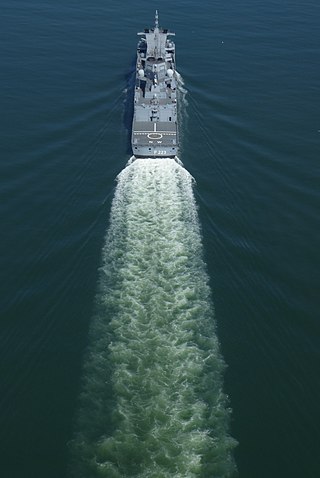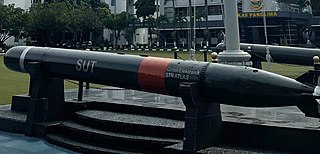SST-3 Seal
| | This section needs expansion. You can help by adding to it. (February 2024) |
The SST-3 entered into service in the 1960s.
| SST torpedo | |
|---|---|
| Type | Torpedo |
| Place of origin | Germany |
| Service history | |
| In service | 1972-Present |
| Production history | |
| Manufacturer | Atlas Elektronik |
| Variants | SST-3, SST-4 |
| Specifications | |
| Diameter | 533 mm |
| Maximum firing range | 37 kilometres (20 nmi) |
| Warhead weight | 260 kilograms (570 lb) |
| Maximum speed | 37 knots (69 km/h) |
The SST family is a series of German torpedoes.
| | This section needs expansion. You can help by adding to it. (February 2024) |
The SST-3 entered into service in the 1960s.
The SST-4 entered into service in the late 1970s. The SST-4 is nearly identical to the SST-3 with the addition of passive homing. [1]
Guidance: The Torpedo was wire guided, but the guidance system only allowed for limited interaction between submarine and torpedo. It featured active and passive homing and could be launched from up to 100 meters deep. Seeker was designed only for surface ships, being superior to original SUT torpedoes at that role, but lacking the ASW capabilities
Range and Speed: Originally featured 2 speed presets, a slower 23 knots speed with a range of 37 kilometers, and a fast 37 knots speed with a range of around 11 kilometers.
Detonator and Warhead: Mod 0 featured an impact fuze, but mod1 also added magnetic fuze, since test showed that seekers winding path could make the torpedo hit target at a sharp angle preventing the contact detonation. Warhead was 260 kg of explosive.
The SST-4 was employed by the Argentine Navy during the Falklands War [2] with poor results. The only Argentine operational Type 209 submarine, ARA San Luis (S-32), fired three torpedoes with no hits after all of them failed to work properly. Investigations conducted by Argentine Navy after the conflict came to the results that there was a problem in the seekers who were assembled wrong, and with the support of the manufacturer fixed the entire navy SST-4 supply in the next years, further upgrading them by the addition of magnetic fuze, performing a successful live test in which the newly commissioned ARA Santa Cruz (S-41) sunk the decommissioned destroyer ARA Py (D-27) on June 15, 1987.
In 2018 the Turkish navy destroyed a target ship with a SST-4 Mod 0 fired from the TCG Yildiray.[ citation needed ]
In 2020 the Hellenic Navy destroyed a target ship with a SST-4, fired from the Υ/Β ΠΙΠΙΝΟΣ 214 HN (S121). [3]

A modern torpedo is an underwater ranged weapon launched above or below the water surface, self-propelled towards a target, and with an explosive warhead designed to detonate either on contact with or in proximity to the target. Historically, such a device was called an automotive, automobile, locomotive, or fish torpedo; colloquially a fish. The term torpedo originally applied to a variety of devices, most of which would today be called mines. From about 1900, torpedo has been used strictly to designate a self-propelled underwater explosive device.
The Mark 24 Tigerfish was a heavyweight acoustic homing torpedo used by the Royal Navy (RN) during the 1980s and 90s. Conceptual development dates to the mid-1950s, and formally started in 1959 with a target introduction date in 1969. A lengthy development process led to a greatly reduced performance requirement, including the removal of anti-surface capabilities. The first prototype "Tiger Fish" examples were delivered in 1967.
The Spearfish torpedo is the heavy torpedo used by the submarines of the Royal Navy. It can be guided by wire or by autonomous active or passive sonar, and provides both anti-submarine warfare (ASW) and anti-surface warfare (ASuW) capability. Spearfish development began in the 1970s, with production starting in 1988, and deployment in 1992. By 2004, the new weapon had completely replaced the older Tigerfish torpedo.

ARA San Luis (S-32) was a Type 209 diesel-powered submarine of the Argentine Navy. Built in Germany, San Luis has a displacement of 1,285 tonnes and was commissioned in 1974. The submarine operated against the Royal Navy during the Falklands War without any noticeable success, but survived a number of anti-submarine sweeps carried out by British frigates. San Luis was struck in 1997 after an incomplete overhaul; as of 2020, its hull remained stored at Domecq Garcia Shipyard (Tandanor).

The Mark 46 torpedo is the backbone of the United States Navy's lightweight anti-submarine warfare torpedo inventory and is the NATO standard. These aerial torpedoes are designed to attack high-performance submarines. In 1989, an improvement program for the Mod 5 to the Mod 5A and Mod 5A(S) increased its shallow-water performance. The Mark 46 was initially developed as Research Torpedo Concept I, one of several weapons recommended for implementation by Project Nobska, a 1956 summer study on submarine warfare.

Type 53 is the common name for a family of 53 cm torpedoes manufactured in Russia, starting with the 53-27 torpedo and continuing to the modern UGST (Fizik-1), which is being replaced by the Futlyar.
The Type 65 is a torpedo manufactured in the Soviet Union and then Russia. It was developed for use against US Navy aircraft carrier battle groups, as well as large merchant targets such as supertankers and advanced enemy submarines. It is now typically fitted to newer Russian vessels, though often the 650 mm torpedo tube is fitted with a 533 mm converter to enable firing of SS-N-15 missiles or Type 53 torpedoes.

USS Bluefish (SSN-675), a Sturgeon-class attack submarine, was the second ship of the United States Navy to be named for the bluefish.

The Sting Ray is a British acoustic homing lightweight torpedo (LWT) manufactured by GEC-Marconi, who were later bought out by BAE Systems. It entered service in 1983.

The Mark 45 anti-submarine torpedo, a.k.a. ASTOR, was a submarine-launched wire-guided nuclear torpedo designed by the United States Navy for use against high-speed, deep-diving, enemy submarines. This was one of several weapons recommended for implementation by Project Nobska, a 1956 summer study on submarine warfare. The 19-inch (480 mm)-diameter torpedo was fitted with a W34 nuclear warhead. The need to maintain direct control over the warhead meant that a wire connection had to be maintained between the torpedo and submarine until detonation. Wire guidance systems were piggybacked onto this cable, and the torpedo had no homing capability. The design was completed in 1960, and 600 torpedoes were built between 1963 and 1976, when ASTOR was replaced by the Mark 48 torpedo.

The Mark 24 mine is an air-dropped anti-submarine (ASW) acoustic torpedo developed by the United States during World War II; it was called a mine to conceal its capabilities. The torpedo entered service with the Allies in March 1943; the United States Navy (USN) used it until 1948. Approximately 4,000 were produced. Of the 340 deployed during the war, 204 were fired, sinking 37 and damaging 18 Axis submarines.

The Mark 37 torpedo is a torpedo with electrical propulsion, developed for the US Navy after World War II. It entered service with the US Navy in the early 1950s, with over 3,300 produced. It was phased out of service with the US Navy during the 1970s, and the stockpiles were sold to foreign navies.
DM2A4 Seehecht is the latest heavyweight torpedo developed by Atlas Elektronik for the German Navy, as a further update of DM2 torpedo which was released in 1976.
The APR-3E airborne light ASW acoustic homing torpedo is designed by Russian Tactical Missiles Corporation JSC to engage current and future submarines at depth from the surface down to 800 metres at speed of up to 43+ knots, and it is a replacement for earlier APR-2 light antisubmarine acoustic homing torpedo.
Yu-5 (鱼-5) torpedo is the first wire-guided torpedo developed by China. It is an ASW torpedo designed for conventional diesel-electric submarines. It is often erroneously referred as the Chinese copy of Soviet TEST-71 torpedo, which is incorrect as the Soviet torpedo was developed in 1971 and its successor TEST-71MKE was developed in 1977, at the worst time of Sino-Soviet split. With Yu-5 entering Chinese service in 1989, it was simply impossible to acquire any technologies of Soviet TEST-71 torpedo, which was not purchased by China until 1993, four years after the Yu-5 torpedo had already entered service. The Yu-5 is not a product of indigenous development and is based largely upon previous Soviet and American designs, with much of the propulsion system being derived from the American Mark 46 lightweight torpedo.
There have been a number of 21-inch (53.3cm) torpedoes in service with the Royal Navy of the United Kingdom.
The Mark 21 Mod 2 torpedo, was a passive acoustic homing variant of the Mark 13 torpedo. It used the widely used Mark 13 torpedo as a basis, with the addition of passive acoustic homing developed by Bell Labs.

Wake homing is a torpedo guidance technique based on the wake trajectory left behind a moving target.

The AEG SUT 264 is a German 21 inch heavyweight wire-guided torpedo produced by Atlas Elektronik which entered service in 1967.
Akya is a new-generation heavyweight torpedo developed by Roketsan for the Turkish Navy. As of 2021, its tests completed, and it went in serial production. "Akya" is the Turkish name of Leerfish.